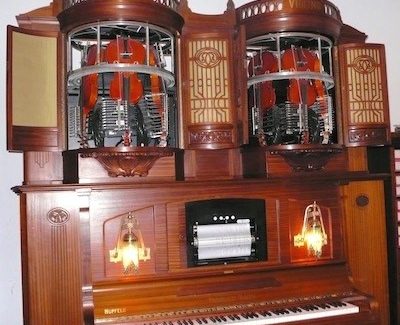Shore Excursion: Visiting Siegfried’s Mechanical Music Cabinet Museum
Today, people can walk around with music in their ears whenever they want. They can plug in and tune out.
But back a couple hundred years ago, people didn’t have that luxury. Only the rich could afford musical devices. And those pieces of equipment were huge.
My shore excursion today was to Siegfried’s Mechanical Music Cabinet Museum in Rüdesheim. Three of us boarded a mini-train to take a short ride from where our ship was docked to the museum. There we got a wonderful tour from guide Michael, clad in old-fashioned attire that seemed right at home in the museum.
“It is almost unbelievable what you are going to hear in here,” Michael said.
He was right. The museum is filled with one wonder after another. A tiny mechanical bird opens its beak and begins trilling a lovely tune. Six ghostly violins in perfect harmony play classical music without musicians’ hands anywhere in sight. A band of 27 dolls, each playing a different instrument, creates a pleasing symphony.
Hard to believe but the more than 350 musical cabinets in the museum are the collection of one man. The story goes that Siegfried Wendel visited Los Angeles on his honeymoon and came across a collection of player pianos and mechanical instruments. Many of the instruments were in poor condition, some destined for the scrap heap. A craftsman, Wendel was fascinating by the self-playing devices and began collecting them. Wendel restored the musical works of art and then wanted to share the music with others.
That’s why in 1969 he opened his collection to the public in his hometown of Rüdesheim. Today, the museum is located in a 15th century manor. Some of the complex music boxes are so tiny – such as the bird on the ornate snuff box – that they can fit in the palm of your hand. Others are so huge that they fill up most of a room.
Remember these devices were all the rage before radios, record players, televisions, and other forms of home entertainment. “If you wanted music in your home and could afford it, this is what you would have to entertain,” Michael said, giving a history behind the instruments and showing how they played and how they sounded.
One scratchy gramophone record sounded like a speeded-up Doris Day singing the words of the song “Que Sera Sera.” “When I was just a little girl, I asked my mother what would I be?” The needle on the oversized gramophone has to be changed each time, Michael said, or it will destroy the record.
An ancient Edison gramophone that uses wax barrels made it sound as though 19th century legend Enrico Caruso was crooning right in the room with us.
The most elaborate instrument is the Orchestrion, a huge musical marvel that plays all the instruments of an orchestra. When Michael cranked up that machine, the sound was almost deafening.
A workshop in the museum shows how the rolls of sheet music and perforated disks were created. So amazing were the sounds for the time, Michael said, that the mechanical music cabinets were considered the work of the Devil or “The Eighth Wonder of the World.”
I thought they were pretty heavenly.
Story and photo by Jackie Sheckler Finch















View Recent Comments